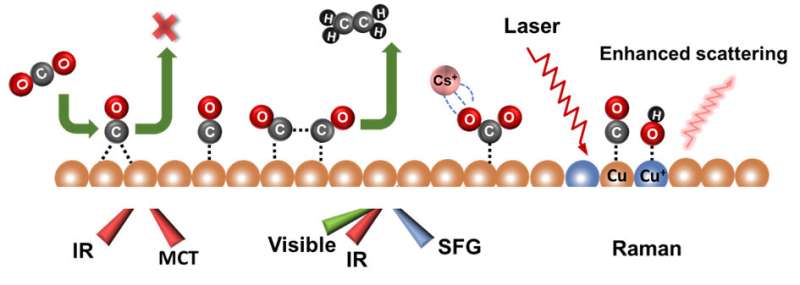Fundamental aspects in carbon dioxide electroreduction reaction tackled by vibrational spectroscopies

Scientists hope that the electricity generated by renewable energy can be used to convert CO2 into value-added fuels, and the stored energy in these chemicals can be released as electricity through fuel cells or other technologies. Such a practice can not only realize the storage of renewable energy, but also mitigate anthropogenic CO2 emission.
Considerable efforts have been devoted to CO2RR and great progress has been made in catalysts, reaction mechanisms, and reaction devices. Strategies for improving the product selectivity and overall reaction activity, such as constructing grain boundaries, controlling crystal facets, forming unsaturated coordination sites or alloys, doping transition metals with non-metallic elements, and surface modification, have been extensively explored.
A large number of works have been focused on elucidating the structure-performance relationship between different crystallographic planes and electrocatalytic activity and selectivity. The effects of different electrode potentials, electrolytes, and solution pH on the performance of CO2RR have also been studied. The key intermediates such as *CHO or *OCCO for the formation of the C1 and C2 products were deduced through experiments and theoretical calculations.
In addition, flow cell and membrane electrode assembly systems were also developed to improve the current density of CO2RR and accelerate the practical application of this process.
Despite the tremendous amount of work on CO2RR, the reaction mechanism together with the structural effects of catalysts and electrolytes remain elusive. These challenges arise in part because the reaction is complex involving multiple electron and proton transfer steps, and in part from the dynamic change of the interfacial structure on both the solution and the catalyst surface sides.
To tackle these challenges, in situ characterization methods that are able to monitor the evolution of catalyst structures in real time during the reaction process, identify catalyst active sites, probe the reaction microenvironment, and capture key reaction intermediates have been employed.
Among them, in-situ vibrational spectroscopy has high sensitivity and interfacial selectivity, and can monitor the catalyst structure reconstruction and the dynamic evolution of adsorbed species during the CO2 reduction reaction, providing important information for clarifying the reaction mechanism and reaction pathways of CO2RR, as demonstrated in literature.
Although many reviews on CO2RR have appeared in the past decade, few of them focused on fundamental problem-solving targeted application of in situ vibrational spectroscopic approaches.
Given the critical information garnered from these methods for the fundamental understanding of CO2RR, a review on this topic led by Prof. Wen-Bin Cai from Fudan University and Prof. Shou-Zhong Zou from American University may stimulate further application and advancement of using in situ vibrational spectroscopic methods in CO2RR studies.
The review summarizes representative results from in situ vibrational spectroscopic studies on key fundamental issues in CO2RR, including (1) the reaction pathways and intermediates; (2) the roles of adsorbed CO; (3) the effects of catalyst structure and (4) the effects of electrolyte. At the end, a brief outlook of the future directions for in situ spectroscopic investigation of CO2RR is presented. This review is published in Chinese Journal of Catalysis.
More information: Hong Li et al, Fundamental aspects in CO2 electroreduction reaction and solutions from in situ vibrational spectroscopies, Chinese Journal of Catalysis (2022). DOI: 10.1016/S1872-2067(22)64095-6
Provided by Chinese Academy of Sciences




















